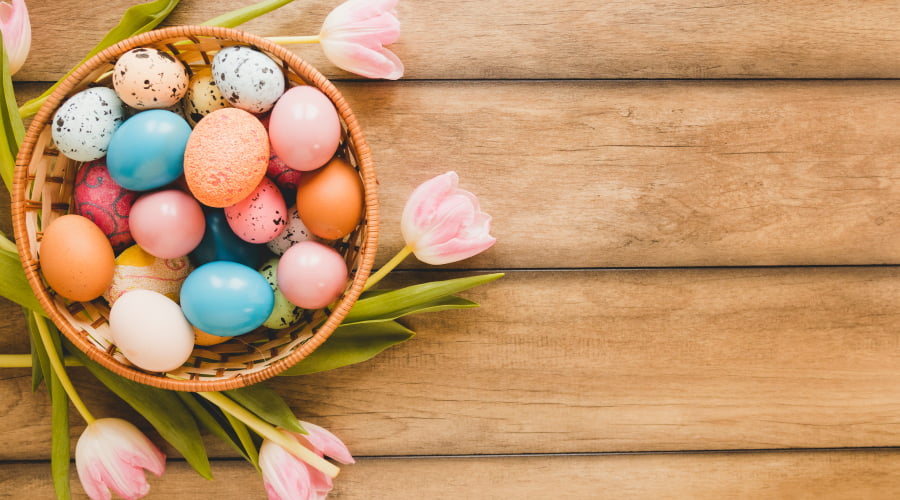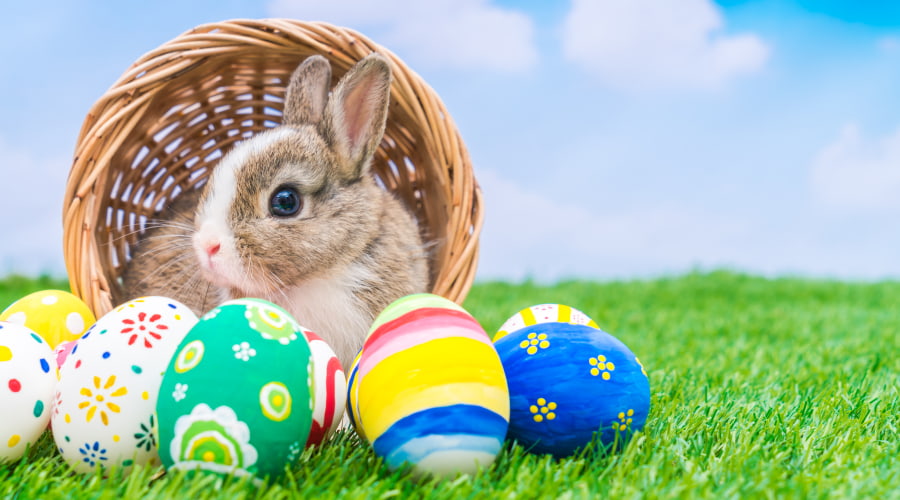Worldwide Easter Symbols, Traditions and Cuisine
Easter is named after Eostre, an Anglo-Saxon goddess of springtime. It has been designated as a holy Day since the First Council of Nicaea in AD 325. It indicates that the event does not take place on the same Julian calendar day every year. The period of Easter is determined by the movement of the Sun and Moon, much like the Hebrew calendar.
All around the world, the most prevalent symbols for Easter are consistent. Who can fathom an Easter without a lamb, a candy rabbit, or handcrafted and decorated eggs? Beautiful Easter symbolism has meaning for us, ranging from lambs to flowers.
Furthermore, Easter has been a celebration of life and feasting since its origin, and numerous and varied activities and traditions of Easter, such as egg rolling, egg plucking, egg cooking, cascaroni or confetti eggs, and egg painting, have developed. Here are some conversation starters for your Easter dinner table from Rosaholics.
Easter Eggs

Why do we have Easter eggs at Easter? Easter eggs are most likely associated with pagan customs. The egg is thought to signify Jesus' resurrection from the grave, as it is an old emblem of a better beginning. Easter egg painting history has been a ritual since at least the 13th century. The origins of Easter eggs began when early Christians in Mesopotamia dyed eggs. The Orthodox Churches accepted the tradition, and it flourished throughout Western Europe from there.
Why do we eat easter eggs? Eating eggs throughout the week leading up to Easter was once forbidden by church officials. As a result, any eggs laid that week were kept and adorned to make Holy Week eggs, which were subsequently presented as a gift to children. Satin-covered cardboard eggs packed with Easter gifts were used by Victorians to modify the ritual. This has evolved into a popular tradition among many people nowadays.
Take a look at some fascinating Easter egg facts.
- Painting eggs is a long-standing custom. 60,000 years ago, archaeologists discovered remains of carved ostrich eggs used as sipping containers in Africa.
- More than 34 feet tall was the world's largest Easter egg. It was created in the Italian town of Cortenuova.
- More than $10,000 was paid for the 110-pound Venezuelan Amedei chocolate egg that was embellished with gold blossoms and cocoa chunks with unique flavors such as Japanese black vinegar and blackcurrant.
Easter Bunny

Although the actual origins of this legendary species are unknown, rabbits are a historical emblem of fertility and new birth due to their prodigious procreation. Bunnies for Easter have become a major emblem of Christianity's most significant festival, even though the Bible contains no reference to a long-eared, short-tailed critter who gives colored eggs to well-behaved youngsters on Easter Sunday.
The Easter bunny story began in the 1700s when German immigrants moved to Pennsylvania and brought their custom of an egg-laying hare. Their youngsters built homes for this animal to lay its colorful eggs in. Furthermore, youngsters frequently left carrots out for the rabbit if it became famished from all of its jumpings.
Check out these Easter bunny facts.
- France commemorates Easter with flying church bells rather than the Easter Bunny. When the bells ring again on Sunday morning, French children discover chocolate bells hidden in their homes.
-
Like their American counterparts, most Australians grew up with the bunnies for Easter. On the other hand, Australians have put the Easter Bunny on warning in the past few decades. This is because rabbits are not native to Australia. Instead, they're exotic species that European immigrants imported there for shooting in the 18th century and which has been wreaking havoc on the native fauna ever since.
- Based on its usually white fur and the pagan lore from which the Easter rabbit leaped, it seems to be an Arctic hare. They can travel at speeds of up to 40 miles per hour, which is how the Easter Bunny travels to every house to distribute the eggs.
Easter Traditional Food
In truth, traditional Easter food recipes differ by country, and some meals have Easter origins dating back to ancient times. From egg hunts and church ceremonies to the many various sorts of traditional Easter meals, every family has its own unique Easter customs.
Candied Carrots

The creamy honey syrup with brown sugar and a touch of cinnamon lightens the attitude of candied carrots, which are a huge family favorite. These are delicious as a side Easter food dish and go well with chicken, pork, and even fish and beef.
Rack of Lamb - France

The greatest roast rack of lamb dishes produces soft, pink flesh with a beautifully browned top. The rack of lamb can be daunting to trim, cook, and serve because of its high price tag, uneven form, and numerous bones. When done correctly, however, it's a flavor-packed show-stopper of the main course.
Babka - Poland

Almost every household in Poland eats a traditional Easter Babka among Easter food. A tiny slice of Babka is typically included in the Easter basket, as well as boiled and painted eggs, butter, ham or cured meat, salt, and bread, which is sanctified on Easter Saturday and eaten for brunch on Easter Sunday.
Jollof - West Africa

In several African cultures, Jollof is one of the most delectable dishes. It is common knowledge that Jollof Rice, particularly that prepared in Ghana or Nigeria, is one of the best delicacies that can be presented to any hungry individual.
Paska - Ukraine

Paska is a sweetish egg bread that can be embellished with religious symbols of Easter. It's customarily taken to church in a special basket with other foods to be blessed on Easter morning. Moreover, Paska is a molded Easter cheese delicacy that can be equally served by Slovaks.
Pizza Chiena - Italy

Pizza Rustica is a delicious Italian Easter pie loaded with eggs, ricotta, salami, and cheese and baked in a flaky, buttery pie shell. It can be cooked with a pizza dough crust or a pastry crust, based on the region. It always has eggs in it, so it resembles a quiche, and it can have a variety of charcuteries.
Capirotada - Mexico

Capirotada is a simple Easter food that blends simple ingredients with religious symbolism to create a unique Mexican dessert that is popular during Lent and Easter. It gets its wetness from a sugar syrup scented with cloves and spices. Dried fruits, fresh fruits, and nuts may also be included in Capirotada.
Tsoureki - Greece

Tsoureki is a wonderful mid-day snack, breakfast, or tea or coffee companion that is traditionally offered in Greece at Easter, and the three braids represent the Holy Trinity. It is also very famous throughout the year as a delightful mid-day snack, breakfast, tea, or coffee buddy. The two aromatic ingredients used in this classic Tsoureki recipe, mastic, and mahlab, give this Greek Easter cake its full and rich flavor.
Mona de Páscoa - Spain

A huge donut-shaped Mona de Páscoa pie is cooked with boiled eggs on top in several locations of Spain as Easter food. Godparents gave it to godchildren, and the number of eggs related to the child's age, according to custom.
Hot Cross Buns - England

Hot Cross Buns have a long and illustrious history that dates back to the 12th century. They're yeast dough sweet buns with spices and a variety of fruits like currants, raisins, and caramelized citrus. The crucifix is represented by a white cross, which is either carved into the dough or imprinted on top with icing.
Easter Flowers

The Easter Lily is, without a doubt, one of the most iconic Easter flowers. The trumpet-shaped white blossoms of white water lilies. They are the traditional Easter flower because they represent cleanliness, virtue, innocence, faith, and rebirth.
Tulips are often referred to as the "harbingers of Spring" since they are one of the first Easter flowers to blossom. Tulips and other spring-blooming bulbs appear to rise from the dead, which is why they are associated with Easter. They have a klaxon flower that mimics an Easter egg's spherical shape.
Daisies are little fragile plants that often bloom in white or yellow. Daisies are the botanical archetypal, and they are frequently the first thing that toddlers learn to draw. Daisies are the Easter flowers that represent purity, simplicity, graciousness, and devotion. This blossom grows wild in grassy pastures and will almost certainly be cradling concealed Easter eggs during your egg hunts.
Throughout the Easter flowers season, single petaled roses are prominent. They have five petals, which signify Christ's five injuries. White roses signify Christ's purity and innocence, while red roses depict the spilling of Christ's blood for the remission of sins.
carrusel_1
World’s Interesting Easter Traditions
Haux inhabitants typically crack over 4,500 eggs into a huge pan to make an Easter omelet. Each family breaks the eggs in their houses in the morning and gathers in the main area to watch the eggs being fried.
In Norway, Easter is a high-crime period. Murder mysteries air on television, and a rush of new detective novels are set to be released right before Easter. People all around the nation retreat to their mountain homes for the weekend to watch TV or read books. Even the milk cartons have little mystery tales on their sides during the season.
Only red eggs are found in Greece. You see, red is the color of life as well as a symbol of Christ's blood. The egg has been a sign of life regeneration since antiquity, and the significance of the red eggs is triumph over mortality.
Conclusion
Traditions are vital to adding to any Easter celebration because they connect us to our past. Rosaholics includes taking the great feelings that this list of the best Easter information will undoubtedly provoke and using them to build your own Easter festivity. Order Easter flowers for a warm family celebration!
FAQ
In 2024, the Easter holiday will occur on 5th of May (for Orthodox Christians) and on 31th of March, for Catholic Christians.
Rabbits typically have a large litter of babies; therefore, they have become a symbol of new life. According to the legend, the Easter rabbit lays, adorns, and conceals eggs.
An Easter Egg is a word for a secret detail in a film that the director left. This aspect could be a message, prediction, all of which are intended to give viewers pleasure.
Around the globe, eggs are a traditional Easter food. The most popular Easter foods are lamb and Easter bread.
Not seen your shipping location? We deliver US Nationwide, visit our Shop All collection to discover the perfect bouquet that best fit your occasion.


















